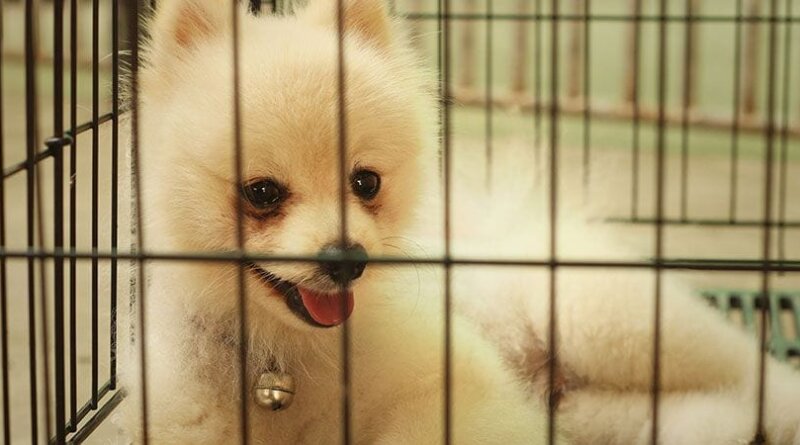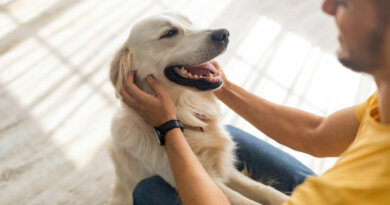Puppy Crate Training Made Easy
There are many reasons you might want to crate train your new puppy. A crate can be invaluable while you are potty-training or teaching your dog the rules of the house, it’s a great way to transport your four-legged friend, and it can serve as a safe place for your pup to escape to once he comes to accept it as his space.
Unfortunately, even though dogs are den animals and they like having an area that’s all theirs, most won’t automatically take to crates — and your pup can even come to fear them if you don’t handle crate training in the right way.
The good thing is that puppies don’t have any preconceived notions about anything. As long as you follow the below tips, your new canine family member should come to love her crate and may even start going into it on her own when she wants to rest or relax.
Kennel Training a Puppy: The Crate Training Process

When crate training a puppy, it’s important to follow the right steps and take your time. Young puppies may feel scared at first, so familiarize yourself with the best practices and possible reactions your puppy might exhibit once you start puppy crate training.
Introduce it Casually
Your puppy’s crate should be like a den, but you’ll need to crate train your pup the right way in order for him or her to view it as a safe space.
The worst way you can introduce your puppy to the idea of a crate is to bring it home and lock him inside it immediately. People don’t like being trapped against their will, and neither do dogs. Instead, you should initially treat the crate like it’s just another piece of furniture — but one that he can enjoy.
To this end, place it in a part of the house that he frequents (like the family room), add a blanket and a toy or two, and keep the door open. Then back off and give him a chance to explore it.
Some dogs will immediately start sniffing around and going into the crate, which is a great sign. If your puppy isn’t quite so bold, encourage him to check it out by placing his favorite foods and toys near and inside the crate. The ultimate goal is to get him comfortable with going inside on his own, and this is something that could take days. Be patient with the process.
If you’re patient, you can help your pet to view their dog crate as their own safe space, so that, when they’re inside, they’ll sit quietly and eventually enjoy going inside their crate.
Use it for Meal Time
Before you start using your crate for meals, make it a fun and interesting place. Add small food treats, a food dish, toys with treats, and more. Most pet supply stores will have the things you need to crate train a puppy. Remember, your goal is to have your dog briefly explore the crate on her own.

After she’s willing to enter the crate, your next goal is to get her comfortable with staying inside for extended lengths of time. One of the best ways to do this (and to create a positive association with the crate) is to start putting her food inside.
If possible, you’ll want to place the food dish at the back of the crate so that your dog goes all the way in. Some dogs may not be willing to do this, though, so you can start with the food just inside the crate and slowly move it back with successive meals.
As she gets more and more comfortable with the crate training process, make sure you start feeding her regular meals inside. Leave the crate door open at first to make sure your puppy feels safe and comfortable.
It’s important to be patient during this part of crate training a puppy! Going too fast can hurt the trust you’re developing with your puppy or older dog, so make sure you take it slowly. It will be well worth it when you have a fully crate trained dog and can leave them alone without worrying.
Make sure your puppy is willingly entering and exiting the crate to investigate the treats before you start closing the crate door at mealtimes. Rushing this introductory phase can cause anxiety.

Close the Puppy Crate
As soon as your dog is eating his meals while standing all the way inside the crate, it’s time to close the door. After he’s done eating that first time, open the door immediately. You’ll leave him in longer and longer with each meal, adding just a few minutes every time.
It’s possible that your dog may whine. If this happens, open the crate immediately and don’t leave him in as long next time. However, your dog whines again, wait until he stops before letting him out, or you will teach him that whining will open the door.
Extend Crate Time
Once your dog is hanging out in her closed crate without signs of stress, it’s time to lengthen her stay. Use a favorite toy or treat to encourage her to enter the crate, then close it. Hang out by the crate for several minutes, then go into a different room for a few minutes so she gets used to the idea of staying in the crate alone.
At this point, your dog may experience some separation anxiety. Creating a positive association with the crate, leaving your dog with something to do, and staying calm throughout the training process will help alleviate this separation anxiety over time.
When you come back after leaving the room, don’t open the crate immediately. Instead, sit with her again for a few more minutes and then open the door. Keep increasing the time as you do this until your dog is able to stay in the locked crate for half an hour without your presence.
Nighttime Crate Training
When she’s able to do this, she’s ready for you to leave her for short periods and possibly even sleep in the closed crate overnight. Make sure you keep the crate relatively nearby for overnight stays though. Puppies usually need a nighttime potty break, and you’ll want to be able to let her out.

Keeping your pup in a crate overnight is a good way to make sure they don’t get into anything while you sleep. You’ll have to work hard to associate your dog’s crate with comfort and calmness. Add a pet bed or a plush blanket so that your pup can spend each night sleeping comfortably. And if you intend to have your dog sleep in the crate often, implement a bedtime routine that is relaxing and soothing. Consistency is key!
Leaving and Returning
You want to make crating seem completely normal and avoid excitement. Encourage him to get into the crate and praise him when he does so, but keep it brief.
Leave quietly, and when you come home, stay low-key and ignore any excited behavior that he shows. Crate training over time will help create a relatively neutral association with the dog’s crate, encouraging him to remain calm and sit quietly inside when crated.
Tips for Crate Training a Puppy: Create a Positive Association With His Kennel

Just like house training, crate training a puppy can be a challenging and time-consuming process, but it’s often essential to ensure your pup is well-behaved and obedient.
When trying to crate train a puppy, it’s very important to take all of the necessary measures to create a positive association with the crate, teach the dog that the crate is a safe space, and make crating a part of their usual routine.
With a new dog, you can follow these tips to make crate training a puppy easier and more effective:
- Choose the right size crate (not too big or too small)
- Let your pup explore the crate on their own before shutting them in
- Make your departures as unemotional as possible
- Don’t reward excited behavior when you open the crate
- Crate your puppy while you’re home so they don’t associate crating with being left alone
- Similarly, put the crate in or near your bedroom if crating overnight
Ultimately, crate training a puppy means you need to take your time and keep them calm. Making a consistent effort to calmly crate train a puppy will pay off!

Dealing With Separation Anxiety Problems
Pet parents hate to see their furry friends anxious and distressed. For many pets, separation anxiety is a chronic issue that can cause problematic behavior.
If your puppy experiences separation anxiety, the best thing you can do for them is create a very positive association with crating. Make their crate a safe space. Stick to a routine, and consistently crate them at the same point in the routine as you’re training them. Stay calm, use commands, and give them something to occupy their time, like their favorite toy.
Crate training shouldn’t feel like a punishment for your pup. Help them understand that the crate is a positive place to be! As you practice keeping them inside their crate, they’ll learn that you will come back and let them out eventually, which will help them overcome their anxiety.
How to Crate Train a Puppy: Using Positive Reinforcement to Train Your Pup
To crate train a puppy, you need to be patient and deliberate for the best results. That means taking your time, letting your dog go into the crate on her own, and creating positive associations with the crate.
Leave your pup with fun toys or treats, and make sure you praise your puppy for good behavior.
Are you crate training your puppy? Share your experiences in the comments.




